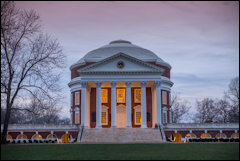If you believe the U.S. News & World-Report college rankings have any value, you might be disappointed to see that the University of Virginia was rated merely the 25th best national university in the country in 2018. But alumni should absolutely dismayed by their alma mater’s performance in the latest Wall Street Journal ranking — 51st!
Be not dismayed, fellow Wahoos. There are many reasons to criticize UVa, as I have repeatedly done on this blog. But this is not one of them. Indeed, conservative and libertarian Wahoos should wear this Wall Street Journal ranking, conducted in partnership with London-based Times Higher Education, as a badge of pride — pride for what UVa has not yet become.
All rankings revolve around the choice of methodology. The WSJ/Times ranking reflect questionable values and priorities. As the ranking explains in its notes, researchers used 15 indicators that assess institutions on the basis of outcomes, resources, “engagement,” and “environment.”
Outcomes (with a 40% weight) include such conventional factors as the salaries that graduates earn and the debt they take on. Resources (30% weight) is a proxy for the resources put into instruction and student service. Engagement (20%), drawn mostly from student surveys, “examines views on things like teaching and interaction with faculty and other students.” And environment (10%) reflects the “diversity” of the university community.
UVa ranks broken down by category:
Outcome: 24
Resources: 192
Engagement: 304
Environment: 476
Apparently, UVa scored poorly on the survey (the methodology for which was not explained), which asked if students felt they had made the right choice, were inspired by their environment, and the like.
The WSJ/Times ranking highlights Brown University as an example of an institution with high “engagement.” What’s the secret?
Provost Richard Locke attributes the school’s high mark for engagement to the fact that students don’t have specific courses they’re required to take. “You only have students in your class who want to be there,” he says, which changes the tenor of classroom conversations.
Brown also encourages hands-on learning through its Engaged Scholars Program, with courses on the anthropology of homelessness bringing students to social-service agencies, for example, or urban-studies students learning about the tactics of community organizers.
No required courses? Anthropology of homelessness? Is it a good thing or bad thing that UVa doesn’t match such an approach? You be your own judge.
As for “diversity,” it’s true that UVa is less racially/ethnically diverse than other institutions — despite strenuous efforts to recruit African-Americans and Hispanics. But assigning that criteria a 10% weight in determining the “Top Colleges” is a raw political statement.
The metric that irritates me most is academic spending per student. UVa spends $22,690 per student, which looks pretty stingy compared to say, $117,990 at Yale. First, there’s a presumption that more spending is better. Second, the metric says nothing about how that money is spent. How much of that spending, for instance, supports expensive R&D programs or pays fat salaries for full professors who do little teaching, benefiting undergraduates not at all? Third, does it occur to anyone that Yale’s spending of $180,000 per student is positively obscene?
When I see what other colleges and universities are doing, I realize that things could be worse. UVa is a mess. But all things are relative. Mr. Jefferson’s University still has a long way to fall.



